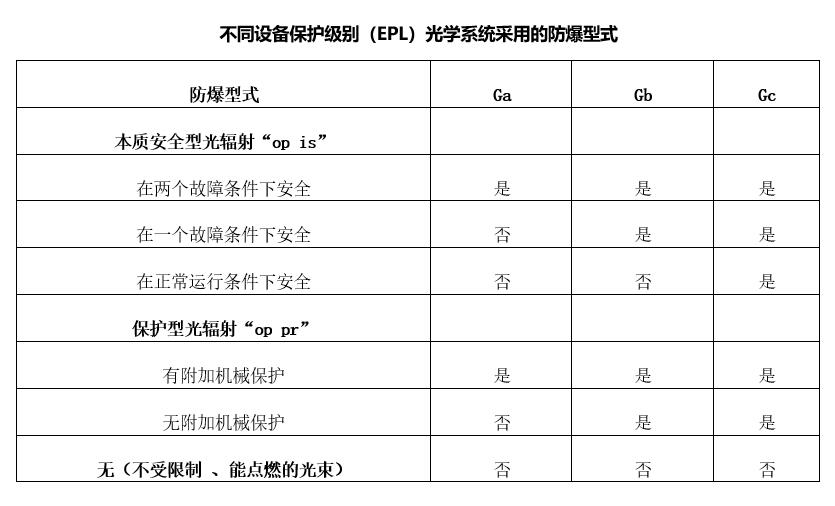
一、光辐射设备在潜在爆炸性环境的实际应用
光辐射传播的不易见性、多光路性和能量交叠等问题,实际上已经引起很多安全隐患,甚至已经造成了很多事故。所以,光辐射设备及传输系统的安全性研究已成其研究的重点。在爆炸性环境中,光学设备多数情况下与电气设备一起使用。比如在通讯、勘察、传感和测量活动中使用的灯具、激光、发光二极管(LED)、光纤等型式的光学设备。这些设备通常安装在爆炸性环境中或者其附近,而且辐射可能通过爆炸性环境。由于辐射自身的特性,可能会点燃周围的爆炸性环境。另外,是否有吸收物存在,也会显著影响点燃。国家对用于潜在爆炸性环境的电气设备有明确的防爆检测和防爆认证标准规定。对用于潜在爆炸性危险环境的光辐射设备,国家GB/T3836.22也有相应的防爆技术要求。
二、光辐射可能点燃的机理有四种:
1、表面或者颗粒吸光光辐射后,温度升高,在某些条件下,会达到点燃周围爆炸性环境的温度
2、当波长与气体的吸收波段匹配时,一定量的可燃性气体发生热点然
3、紫外线波长范围内的辐射使氧分子光解,形成光化学点燃
4、强光束聚焦处激光直接导致气体分解,产生等离子和冲击波,二者终成为点燃源。接近分解点的固体材料会加剧这个过程。
我们所说的GB/T3836.22光辐射设备仅适用第1和第4点的波长范围为380nm-10µm点燃可能。
三、光辐射设备的三种防爆型式
防爆电气光辐射设备op型可用三种防爆型式来防止潜在爆炸性环境中光辐射造成的点燃。这些防爆型式适用于所有光学系统。
这三种防爆保护型式是:
 本质安全型光辐射,防爆型式为“op is”;
本质安全型光辐射,防爆型式为“op is”;
 保护型光辐射,防爆型式为“op pr”;
保护型光辐射,防爆型式为“op pr”;
 带联锁装置的光学系统,防爆型式为“op sh”;
带联锁装置的光学系统,防爆型式为“op sh”;
1、本质安全型光辐射,防爆型式为“op is”
(1)指在正常条件或规定的故障条件下,产生的大能量不会点燃特定爆炸性环境的可见辐射或红外辐射。 能引起被辐照体吸收点燃的可见波谱或红外波谱的能量、功率或辐照度很小,通过限制光束强度可达到安全程度。本质安全型光辐射原理适用于自由辐射,不限制环境中是否有吸收物,具有极大的使用灵活性。
(2)不同设备类别和温度组别的光辐射功率或光照辐度详见下表

(3)本质安全型光辐射设备的配套使用
采用本质安全原理的光学器件,在功率/能量超标时,应提供故障保护措施,防止潜在爆炸性环境中出现超强度光辐射。并应进行危险/危害分析,确定何时需要这些器件。 要考虑光源故障模式 、电源隔离以及是否出现爆炸性环境的情况,确定是否需要附加保护 。像激光二极管或发光二极管(LED)这样的光源,在功率超标故障条件下如果过热,则会出现故障。某些光源的热故障特性可提供必需的功率超标故障保护措施 (10 个样品试验)。光源和电源之间设置限流和/或限压器件的电路 ,能够防止类似于本质安全电路的功率超标故障。
(4)本质安全型光辐射设备的保护级别(EPL)
功率超标故障保护措施应与设备保护级别(EPL)相适应。 对于Ga级设备,例如,限流和/或限压器件在施加两个可计数故障后 ,应能提供功率超标故障保护。 对千Gb级设备,施加一个可计数故障。 对于Gc级设备,应取额定值,不考虑任何故障。某些小功率光源,如发光二极管的热故障特性,可用于任何保护级别的功率超标故障保护。
2、保护型光辐射,防爆型式为“op pr”
(1)保护型光辐射要求把辐射限定在光纤或其他传输介质内,并且假定辐射不会从限制范围内逸出。辐射限定措施决定了系统的安全水平。根据假定条件(故障条件或正常运行)进行危险分析,提出安全要求。
(2)采用符合有关防爆型式标准要求(GB/T 3836系列)的外壳时,外壳内部允许有点燃源,但不能点燃外壳外部环境 。
(3)光纤内辐射:正常运行条件下,光纤能防止光辐射逸出到环境中。对于可预见的故障,可采用铠装 、导管 、电缆桥架或电缆管道提供保护。
(4)外壳内辐射:可能出现点燃源的外壳,如果符合GB/T 3836系列标准规定防爆型式的要求(隔爆外壳"d"、正压外壳''p" 、限制呼吸外壳等),则外壳内可以有易燃辐射。 但是,逸出外壳的辐射应按本部分的要求进行保护 。
3、带联锁装置的光学系统,防爆型式为“op sh”
(1)如果辐射限定措施失效,失效时间小于点燃延迟时间,而且在有联锁断开装置的情况下辐射成为非 本质安全状态,则应采用这种保护型式。
(2)应根据危险分析确定的要求,启动联锁断开装置。有关标准(如GB/T 20438 、GB/T 21109)规定的方法。可用于分析不同保护级别的设备所具有的安全概率或危险降低系数,如表3所示 。

四、光辐射设备防爆认证适用的标准
1、国内标准:GB/T 3836.22-2017《爆炸性环境 第22部分:光辐射设备和传输系统的保护措施》
2、国际标准:DIN EN/IEC 60079-28-2015 Explosive atmospheres - Part 28: Protection of equipment and transmission systems using optical radiation
五、光辐射防爆保护型式的适用性

本文版权归中诺检测所有,抄袭盗用我司将保留追究权利,转载请必须注明原文出处。